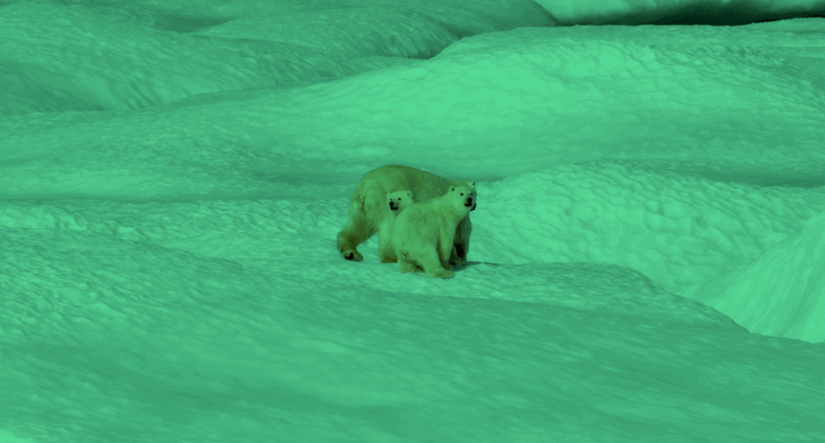Climate skepticism 101 - are we responsible?

Climate change is happening, right? If we can’t all agree on that take a look at part one of our Climate Skepticism for Dummies series. We explained the multitude of evidence scientists used to confirm the threat posed by global warming and its effect on our land, air and water. So, if that’s settled how do we know what’s really causing it?
Even if you understand that science confirms the planet is heating up as surely as it confirmed the Earth goes around the Sun, you might remain unconvinced that the culprit has been caught, tried and convicted.
Well, fair enough, let’s look at the evidence pointing to the weapon and the perp.
What is the greenhouse effect and how is it linked to CO2 and global warming?
Global warming has been anticipated for a long time.
In the first part of our series we mentioned the initial findings of the 19th Century French scientist Joseph Fourier.
In 1827 Fourier published a paper which pointed out a simple but previously unnoticed fact: Earth is too warm. He had calculated that, given its distance from the Sun and its size, our planet should be much colder than it is.
The incoming solar radiation we get each day just isn’t enough to explain our temperate climate if it is disappearing away into space once the sun sets. Fourier realized that something must be causing the heat we get from our star to build up over time.
He theorized that the atmosphere was a kind of one-way door, allowing solar energy to enter but stopping much of the heat radiating back off the Earth from escaping.
The scientist, who had once worked for Napoleon, had discovered the greenhouse effect, but he didn’t know the exact mechanism that was causing it.
The smoking gun
Carbon dioxide (CO2) is called a “trace gas” and has long been present in small proportions in the atmosphere due to natural phenomena such as animals breathing, decomposing organic matter and the odd volcanic eruption.
From the early 19th Century carbon dioxide levels shot up from around 280 parts per million (ppm) to about 400ppm today. It is currently rising at a rate of about 2ppm per year, but that rate is accelerating.
This means in one million particles of air there are currently about 400 molecules of carbon dioxide.
If that doesn’t sound like a lot, try hanging out in a room with 500ppm of hydrogen sulphide in the air and see what happens. Hint: prepare to keel over immediately, lose your ability to breathe and face a rapid and painful death. Exposure to even just 50ppm of this gas can lead to eye damage.
Ok, we’ve established bad things can come in very small packages, what’s that got to do with global warming?
In the later half of the 19th Century, work done by Irish physicist John Tyndall and American scientist Eunice Newton Foote identified that CO2 had very potent heat-trapping properties, making it a prime candidate for the mechanism suggested by Fourier.
Obviously science isn’t a case of publish and be believed. The pioneers of the global warming hypothesis faced a lot of skepticism from other scientists, who critiqued their work, checked their methodology and repeated their experiments.
Over the course of the 19th and 20th Centuries, their findings were verified and became accepted on the strength of the evidence backing them up. Other scientists added to the hypothesis as time went on.
In 1895 for example, Swedish scientist Svante Arrhenius presented a paper which calculated the effects of increasing and decreasing amounts of atmospheric carbon dioxide on the Earth's temperature.
He worked out that an increase of two and a half or three times the amount of CO2 then present in the air would raise the temperature of the polar regions by about 8 or 9℃.
In the 1890s, this didn’t seem like a particularly pressing problem. It was thought that thousands of years would pass before the rate Victorian-era emissions increased to a dangerous amount.
But, by the early 20th Century, industry had expanded so much that the time taken for the doubling of output was reduced to a few centuries.
Of course, this was before the widespread adoption of cars, the invention of air travel and the mass electrification of homes and businesses. In terms of CO2 emissions, we were just getting started, and now the time-scale is down to decades.
How exactly does CO2 affect the climate?
We know that despite its status as a “trace” gas in the atmosphere, CO2 is very good at absorbing the thermal radiation emitted from Earth’s surface.
There are other gases with similar properties, including methane, nitrous oxide, and fluorinated gases, but we’ll look at those a little bit later.
The heat energy from the sun arrives in a variety of forms, or scientifically speaking, wavelengths. The different wavelengths behave in different ways.

The sunlight which helps you get about during the day is at a wavelength visible to the human eye. Other forms of heat from the Sun include ultraviolet radiation which has a wavelength too short for us to see and infrared radiation which is too long to see.
So, when the energy enters Earth’s atmosphere, some wavelengths bounce off clouds and the polar ice caps and back into space, some make it to the ground and get reflected there, others are absorbed by dust particles, water vapour and gases in the atmosphere.
The Earth temporarily stores the rest in the land and in the oceans, releasing it again over time.
As the Earth releases this stored heat, much of it is absorbed or reflected back down to the surface again by clouds or gases in the atmosphere such as, yep you guessed it, CO2.
But wait, it doesn’t stop there. The heat ping pongs between the sky, the land and the sea some more. This is why most of it stays in the atmosphere rather than venting off into the big black.
The whole process keeps the Earth fairly cosy compared to the −270.45 °C of outer space. This is what we call the greenhouse effect.
For millennia, this was a fine system which insulated the Earth well enough for life to flourish and give rise to the kind of animals that like to create wonderful things like the Taj Mahal, space rockets and the Masked Singer.
In fact, scientists call Earth the Goldilocks planet, it’s not too hot, not too cold.
But, like Goldilocks discovered, you can have too much of a good thing. The lead-melting temperature of Venus for example is 464°C. Earth’s twin planet has an atmosphere of 96.5% CO2 and as a result it suffers from a runaway greenhouse effect.
We didn’t know it at the time but our three bears came home with the industrial revolution in the form of coal, oil and gas.
While we worked out clever ways to get porridge and everything else more quickly, more cheaply and in ever-vaster quantities, we were pumping CO2 into the atmosphere in unprecedented amounts.
On top of that we cut down forests and cleared land for mining, building and agriculture.
Remember, trees and other plants breathe in CO2 and breathe out oxygen as part of the carbon cycle.
So, not only were we adding extra amounts of carbon dioxide to the atmosphere, we were also upsetting the equilibrium established over millions of years by the biosphere, the interdependent system of plants, animals and the Earth interacting with each other.
Reducing the natural capacity of the biosphere to handle the existing CO2 while adding even more to the system is a bad idea when you understand the heat-trapping abilities of the gas.
The insulation effect would get too strong and the Earth would overheat. The greenhouse effect would go out of whack and lead to global warming and its consequences, or in other words you would get climate change.
That’s the hypothesis but what is the evidence?
By the end of 2019 industry and burning of fossil fuels added an estimated 36.8 billion tonnes of carbon dioxide directly to the atmosphere. When other human activities are taken into account such as agriculture and land use, the total is about 43.1 billion tonnes.
The rising levels are seen in measurements from monitoring stations in dozens of countries around the world and from satellites in orbit.
At the same time, scientists see atmospheric oxygen levels declining as would be expected with the rise of CO2 levels. This is because it is being consumed in the process of burning fossil fuels and transformed into carbon dioxide.
Carbon comes in many forms, the most common are carbon-12 and carbon-13. Plants prefer to absorb the first type. As fossil fuels are actually plants and other biomass, transformed by heat and pressure over millions of years, the carbon they contain is carbon-12.
When the fuels are burned, the carbon-12 locked up eons ago is suddenly released back into the atmosphere.

Knowing this, scientists studying the extra CO2 in the atmosphere looked at what type of carbon it was and found it overwhelmingly contained carbon-12, adding more confirmation to the prediction that burning coal, oil and gas was leading to the accumulation of CO2 in the atmosphere.
The oceans accumulate carbon dioxide as well, so what evidence can be gathered from there to add to the case against human emissions?
If more CO2 is being absorbed by the oceans, the water should turn more and more acidic, which would be expected to affect sensitive plants and animals first.
As we saw in part one, the disastrous decline of coral reefs shows the oceans are indeed becoming acidic by absorbing too much of this sharply increased amount of carbon dioxide.
What's more, examination of corals from across several centuries show a rapid uptake of fossil-fuel carbon in the last century and a half.
If CO2 is insulating the Earth, the amount of heat escaping into space should be lower at the wavelengths it is known to absorb.
Satellites have been used to check this hypothesis and have confirmed that heat loss at those wavelengths is indeed falling and moreover, the measurements correlate with the increase in temperature at the surface.
The heat reaching the ground is also found to be increasing more at the exact wavelengths reflected by CO2. This is yet more direct evidence of the increasing greenhouse effect.
Another prediction is that the greenhouse effect should work at night as well as during the day, because the CO2 doesn’t go away, nor do the Earth and sea stop releasing heat when the Sun sets.
It should in fact be more noticeable at night because the Sun is temporarily removed from the equation.
Looking at the data, scientists do indeed find that the average nighttime temperature is rising faster than the average readings for the daytime.
The atmosphere, like the land or the ocean has many regions, which should respond differently if the greenhouse effect is accelerating.
For example, if the heat is being trapped by CO2 in the lower atmosphere as the greenhouse effect hypothesis predicts then the upper regions of the air should be cooling down.
Measurements of the stratosphere and the ionosphere, the upper regions, confirm that these layers are getting colder. This is because less heat is rising past the troposphere, the lower layer where most clouds and our weather systems form.
A warming troposphere and a cooling stratosphere should lead to another effect which can be checked and added the pile of evidence we’ve put together.
The lower layer and the upper layer are separated by something called the tropopause.
A warming below combined with a cooling above should cause the tropopause to rise. This effect has also been measured and confirmed.
Another way of testing the relationship between CO2 and the planet’s temperature would be to look at the historical record and find a pattern of rising CO2 followed by rising temperatures.
Various pieces of evidence from ice cores to tree rings show that yes indeed, in the past whenever the CO2 level increased, the temperature of Earth also went up, but we’ll look at the historical evidence in a later article in this series.
Is CO2 working alone or with accomplices?
There are other gases contributing to the greenhouse effect.
You might be shocked to learn that plain old water vapor is the most common greenhouse gas in the atmosphere. It is both a cause and consequence of global warming.
Higher temperatures cause more water to evaporate, more water vapor causes higher temperatures, which in turn causes even more water vapor to evaporate into the air.

This spiral of doom is called a feedback mechanism by scientists. However, there’s not much we can do to reduce the amount of water vapour in the air except reduce the other greenhouse gases.
Another problem gas is methane, produced naturally and by humans, mainly through farming and landfill waste. While methane is thousands of times more potent than CO2, for now there is a lot less of it in the atmosphere. It contributes about 17% to the greenhouse effect.
Vast stores of natural methane are locked up in the oceans and the arctic tundra.
The rising temperature could cause these to be released causing climate change to accelerate out of control, what scientists call a “tipping point”. Expect to be hearing much more about this hydrocarbon gas in the future.
Nitrous oxide, another potent gas used in industrial processes and in fertilizers, is causing around 6% of the greenhouse effect.
Why concentrate so much effort on CO2?
Scientists rate greenhouse gases in terms of something called “radiative forcing” (RF).
The RF indicates how much each gas is responsible for the increase in the amount of energy reaching Earth’s surface. When all things are taken into account, CO2 has the highest RF value.
In simple terms this means that, although other gases may be more potent than CO2, they are not as abundant in the atmosphere and do not pose as immediate a threat.
Researchers attribute 64% of human-induced global warming to carbon dioxide and there is presently 40% more of it in the atmosphere than at the beginning of the industrial age.
Another major factor that makes CO2 so dangerous is that it hangs around in the atmosphere for much longer than the other greenhouse gases.
Water vapour is recycled by the biosphere in as little as ten days, methane has an average life of around ten years before it decays into CO2 and nitrous oxide will be absorbed in about one hundred years.
However, CO2 takes between 100 and 10,000 years to be removed from the atmosphere.
This means the effects of carbon dioxide released at the very beginning of industrialization are being felt today and emissions we pump out now will still be over-heating the Earth in the days of our great-grandchildren and their great-great-grandchildren and on and on for ten millennia.
What happens next?
So, it should be obvious by now that CO2 is indeed the weapon and we’re the ones accidentally responsible for pulling the trigger.
But the verdict and sentence for the crime is up to us.
Do we do nothing and suffer the consequences of an unchecked greenhouse effect and force those consequences on our children and all their descendants?
Or do we try to make up for the unintended but deadly mistake we should all now understand we’ve made?
Is it to be climate murder with malice aforethought and a death sentence for our way of life?
Or climate assault and battery with justice served by community service?
There are many ways we can undo some of the damage already caused.
True, many of them involve lifestyle changes, but small voluntary changes now will mean fewer drastic changes being imposed on us by the climate or the government in the future. The choice is still ours, at least for the moment.
One of the easiest and most effective ways to bring down our CO2 emissions is by rejecting fossil fuels and supporting green energy production.
Here at the Switch we’ve got the expertise to help you find a renewable energy supplier to fit your needs as well as your pocket. Start your climate-saving switch today.
by Damien Crossan
